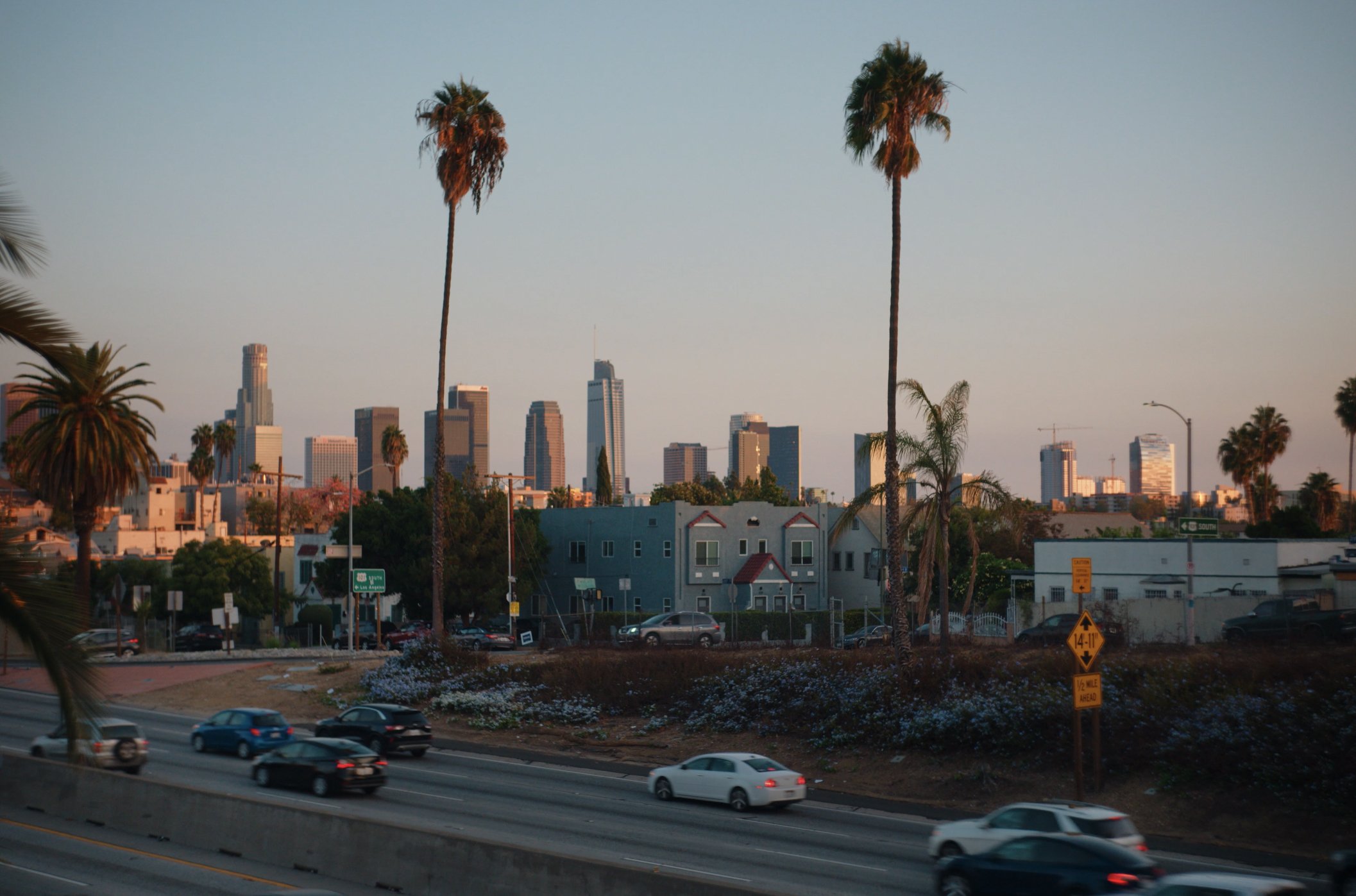Theory of Change
It is essential that we combine our efforts to solve the housing & Homelessness crises, global warming and racial inequity through a holistic approach.
In 2005 we began building permanent housing for our unhoused neighbors, many of whom were living with mental illnesses. In the last 18 years we have built a dozen residential spaces across LA County that are now home to nearly 1000 people. Yet, while we are providing a safe home and supportive services for our residents, we have come to realize that we are not doing enough; the impact of global warming and rampant inequity continue to threaten the basic needs of far too many Angelenos. Everyone deserves access to a safe home and clean air, water, and food. Without having these basic needs met you are so focused on survival that you will never have the opportunity to lead a fuller life.
For too long we have attempted to resolve these issues through disparate strategies and mutually exclusive solutions. We believe that housing developers must approach these challenges holistically because they are inherently inter-connected:
The housing and homelessness crises have continued to grow due to the industry’s inability to produce enough housing to meet the need.
The effects of global warming have become increasingly felt by all Angelenos in the form of extreme weather including drought, fires, heat and rain.
Systemic racism has disadvantaged communities of color for generations resulting in disproportionate levels of homelessness, housing insecurity and home ownership.
Each building that we develop has the power to clean the air, preserve and recycle water, provide open space, address food insecurity, increase wildfire resilience and provide opportunities for economic mobility – this is the future we’re working to build. It is essential that we combine our efforts to solve the housing and homelessness crises, global warming and racial inequity through a holistic approach designed to create opportunities for all Angelenos to lead fuller lives.
Click to learn more about our work in each of the following areas:
Root Causes
The housing and homelessness crises, global warming and racial inequity did not become critical issues overnight. Each have been building for decades, if not hundreds of years and will not be solved overnight. Yet it is important to understand some key aspects of how these crises emerged if we are going to build support for holistic solutions.
-
In the post-World War II boom, veterans were coming back and demand for housing was high. With the creation of quickly-built housing powered by the Levittown model, more and more Americans were becoming homeowners – but the benefits that policies like the GI Bill were not available to many Black, Latino and other nonwhite first-time homebuyers.
Additionally, prior to World War II many parts of Los Angeles were ranked by mortgage risk assessment standards that were explicitly racist in practice and in language, outlining areas in red that were primarily nonwhite – discouraging investment in areas like Boyle Heights and Watts. The effects of this policy are still being felt today, with communities of color having a higher likelihood of living in areas with higher rates of asthma, cardiovascular disease, poverty and unemployment. Effects of racist planning policies a century ago are still felt and perpetuated today, even if those policies were reworked ages ago.
-
While there was a boom of housing being built, the production of housing did not remain constant throughout the years. During the 1940’s through the 1960’s, the amount of areas in Los Angeles and Long Beach where housing was built was over 95%. The same region experienced less than 50% of construction from 2000 to 2016.
As housing production went down, the cost of living across the board continued to rise. The median age of first-time homebuyers in 2022 was 36, compared to 29 in 1981 – a trend influenced by the growth of home values in comparison to wages. If the cost of housing stayed constant with the cost of living, an average home would be approximately $180,000 – a price much lower than the average cost of a home in Los Angeles.
This means that renters are increasingly less likely to purchase a home, and more likely to fall behind on rent - a reality for more than 5 million renters in the United States.
-
As a response to this issue, the Low-Income Housing Tax Credit (LIHTC) was implemented in 1986 as a way to spur the development and renewal of affordable housing through private investment in the form of tax credits. However, the funding that LIHTC provides oftentimes isn’t enough on its own to build affordable housing, and the challenge of coordinating several other funding sources means that projects take longer to build. Recent policies implementing tax cuts have also impacted the power of LIHTC, reducing the incentives for private investment towards housing.
While LIHTC does build housing meant for low-income renters, it isn’t always enough - with renters saying that at times, “paying rent is a struggle.”
-
Additionally, LIHTC funding doesn’t always cover the infrastructure needs to combat emerging and present-day challenges that result from global warming, pollution and energy consumption. Droughts in California have intensified in the past 20 years as a result of increased heat here in California and across the country, leading to more wildfires that intensify future cycles of drought and expand the ever-growing fire season. We are already seeing people within California fleeing the impact of global warming, and this trend will continue across the country and the world as temperatures rise.
In order to build resilient housing while mitigating pollution caused by construction and existing buildings, we must innovate in how we build housing that responds to these environmental challenges and addresses historical inequities.

Sustainability
The way we have become accustomed to building, transporting ourselves and living in Los Angeles isn’t sustainable. There simply aren’t enough resources to keep developing this way anymore – land, water, building materials, to name a few. Furthermore, a large majority of the city is zoned for lower density, single-family homes and, instead of building denser, multifamily housing, our reliance on cars has fueled urban sprawl. Parallel to this, we’re struggling to adapt to increasingly extreme weather.
If we are going to combat global warming, we need to lower our carbon footprint and be smarter about the way we utilize our finite resources. We need to create new ways of living together through holistic, intentional design that leverages sustainable building practices including reducing our use of concrete, focusing on net zero operations by going all electric, recycling and redirecting water, building by high frequency public transit, pairing park space with living lungs that clean contaminants from the air, etc.
We can build a more sustainable and equitable LA by focusing on density, walkability and access to shared green spaces for all. In this manner, the city and specifically its residential buildings, can become the catalyst for solving global warming while meeting our housing needs.
Our Work in the Space
1.0
Operational Since 2008
17 Units, Long Beach
Completed in 2008, Elm Avenue Apartments is our oldest property and our first to feature photovoltaic solar panels that generate electricity for the building, reducing its reliance on the electrical grid. Elm Avenue Apartments features 48 solar panels that generate 13,000 kilowatt-hours of electricity annually. In the last 15 years we have installed 106 solar panels (used to generate 41,000 kilowatt-hours of electricity annually) and 221 solar collectors (used to heat water, saving 241,000 thermal kilowatt-hours of energy annually) in 7 of our 12 operational properties.
2.0
Under Construction, Opening 2023
54 Units, Los Angeles
Currently nearing construction completion, Isla Intersections goes way beyond solar panels. To start, by siting within high frequency public transportation and through intentional stacking of the shipping containers, we were able to skip the concrete podium required for parking lots. Aside from the communal laundry rooms, all units will use all electric appliances. Finally, Isla Intersections will feature our first Living Lung, a lush landscape a comprised of carefully selected plants and trees that will clean the air and reduce noise and light pollution from the surrounding freeways. Additionally, the property will save water by irrigating the Living Lung with recycled greywater from the buildings’ sinks and laundry machines.
3.0
Pre-Development, Breaking Ground 2025
Approx. 100 Units, Long Beach
Located in Long Beach, Denali, named for the tallest mountain in North America is shaping up to be our most ambitiously sustainable project to-date. In addition to being our first high-rise project, Denali will feature extensive solar panels, use all electric appliances, employ mass timber instead of the usual concrete associated with high-rise buildings, and set the ambitious goal of Net Zero Operations, meaning the amount of greenhouse gases emitted is balanced out by the amount of gases it removes from the atmosphere.
Diving Deeper

Housing Financing
The way that we finance the construction of affordable housing in Los Angeles is complicated, takes a long time and is incredibly expensive. Even though most of the funding for affordable housing comes from investors utilizing the Low Income Housing Tax Credit (LIHTC) program, cities, counties, states, the federal government, and private foundations also contribute money. All of these programs are incredibly competitive and it often takes years to piece together all of the money which results in higher costs – considerably more than market-rate developers face.
To build enough permanent housing to keep our unhoused neighbors off the streets and keep rent-burdened Angelenos from becoming unhoused, we need to make it easier to build faster and cheaper. So how do we do that in this complex, time intensive and high-cost environment? We can speed up the process by securing land from public jurisdictions, siting by public transit to reduce the need for the expensive parking structures and utilizing faster building methods like modular construction. These strategies can speed up the process considerably and reduce costs by 33% and complete projects 25% faster.
In addition to our robust Low Income Housing Tax Credit (LIHTC) pipeline, we are growing our Advancements pipeline (non-LIHTC) so that we can build enough housing for all by making the process faster, cheaper, and less complicated.
Our Work in the Space
Under Construction, Opening May 2023
75 Studio Apartments, Hollywood
Avenida is our first property to leverage Project Homekey, California’s program that began as a short-term, COVID-era idea and has since expanded to become a single source financing tool enabling developers to move quickly and purchase and rehabilitate under-utilized hotels and motels. Compared to the average 6 year timeline and $775,000/unit cost of LIHTC projects, Avenida will be completed in nearly 13 months and at $455,000/unit. Additionally, Avenida is transit-adjacent with a Metro stop on the same block, reducing reliance on cars.
Under Construction, Opening Summer 2024
97 Studio Apartments, Whittier
Laurel Grove is our second Homekey site and our second to feature a Living Lung; an extensive landscape of carefully selected trees and plants designed to reduce contaminants from the air, as well as noise pollution from the adjacent 605 freeway and irrigated by a greywater system. It will also contain a pocket park that is open to residents and the entire community. Additionally, by rehabilitating an existing building we will avoid the usual carbon emissions associated with new construction. These innovative sustainability features are doable in part because of the time and money saved through Homekey’s single source financing. Like Avenida, the project is slated to be completed in a year and cost $333,000/unit, a fraction of the average affordable development.
Pre-Development, Breaking Ground Fall 2023
90 Two-Bedroom Apartments, Wilminton
Safe Harbor 1 and 2 are the first two projects to move through our new Advancements pipeline meaning that they will not rely on tax credits to build. We have reduced costs by designing without the usual concrete podium required for parking and by utilizing a modular construction method.
Diving Deeper

Equity
A more equitable Los Angeles would be able to produce enough housing the ensure that everyone was able to afford a place to live. A more equitable LA would have accessible and affordable transportation, high quality jobs, safe parks and streets — opportunities for ALL Angelenos to lead fuller lives. Equitable communities are those in which everyone’s basic needs are met; physical, social, and mental well-being at all stages of life so that, instead of surviving paycheck to paycheck, they are free to focus on achieving their full potential.
At Holos Communities, we began by creating permanent supportive housing for our unhoused neighbors and have gradually expanded our focus to include the creation of more equitable communities. This is because our homelessness crisis is a part of the housing crisis and our inability to produce enough housing impacts nearly everyone. A majority of Angeles spend more than 1/3 of their income on housing with the idea of home ownership completely out of the picture while businesses struggle to retain employees due to high housing costs. Working class families need affordable housing but so do seniors (the fastest growing homeless population) and college students (with nearly 20% of CA Community College students experiencing homelessness or housing insecurity).
Although the task is daunting, these are the challenges we embrace everyday at Holos. This is why we are focused on holistically fostering more equitable communities:
We need to derive new models to solve our housing and homelessness crisis.
All communities need to be more resilient to the impacts of global warming.
We need to improve the process of financing the construction of housing, so it is cheaper, simpler, and faster to build enough housing for everyone.
By incorporating commercial spaces within multifamily affordable housing properties we can make neighborhoods more walkable and friendly to small businesses.
To reinforce our social safety net and reduce socioeconomic segregation, we must create more stepping stones to reduce the large gap between publicly subsidized and market rate housing.
Our Work in the Space
In Operation Since 2021
48 Units, Long Beach
Located blocks away from the nearby Metro line, Vistas del Puerto includes 48 units, half of which are affordable apartments for families and half are permanent supportive housing for formerly unhoused individuals and people with chronic health conditions. The property features two communal kitchens, a playground and two commercial spaces that are being prioritized for small, Women or BIPOC-owned businesses at a discounted rent.
Under Construction, Opening 2023
54 Units, Los Angeles
Located at the intersection of the 110 and 105 freeways in South LA, Isla Intersections will provide permanent supportive housing to 54, formerly unhoused individuals with 10 apartments reserved for veterans. In addition to its innovative shipping container build, the Annenberg Paseo will make Isla a destination for the community. What was a freeway adjacent street will become a public greenspace full of lush landscaping designed to reduce pollution from the nearby freeways along with two commercial spaces that are being prioritized for small, Women or BIPOC-owned businesses at a discounted rent.
Under Construction, Opening 2024
180 Units, Panorama City
Our largest property to date, Corazón del Valle — named after its location in the heart of the San Fernando Valley — half of all apartments provide permanent supportive housing to formerly unhoused individuals and people with chronic health conditions. The other half will be affordable apartments for families. The building will house a neighborhood clinic operated by the San Fernando Valley Community Mental Health Center that will be open to both the tenants of the building and the greater community. The property is also located blocks from a new Metro rail line set to run north along Van Nuys Blvd
Diving Deeper

Small Business Resiliency
Helping a small business thrive means entrepreneurs and employees can stay employed, money can be reinvested in the local economy and most importantly, individuals and their families remain housed.
Initially developed in response to the local economic consequences of the COVID-19 pandemic, Holos’ Small Business Resiliency Strategy (SBRS) is an important step forward in addressing the organization’s goals of creating spaces for all and providing opportunities for fuller lives. The SBRS makes available Holos commercial spaces to small, local, women- and/or BIPOC-owned businesses at discounted rental rates, and with other financial assistance such as a Tenant Improvement (TI) loan from a local Community Development Financial Institutions CDFI. Ultimately, through the parameters developed through this program, Holos is looking to enhance local economic growth that can be become part of a broader and resilient approach.
By prioritizing these small, local, BIPOC-owned businesses, the SBRS helps to allow these entrepreneurs to subsist on their own by maintaining a stable income stream, thereby preventing dire circumstances, such as future homelessness. By reducing commercial rent and assisting with TI loans, the SBRS increases a business’ disposable income, which can be reinvested in the local economy. The business can also then bring on employees at a living wage, further reducing potential future homelessness, as most households in LA are rent-burdened.





















